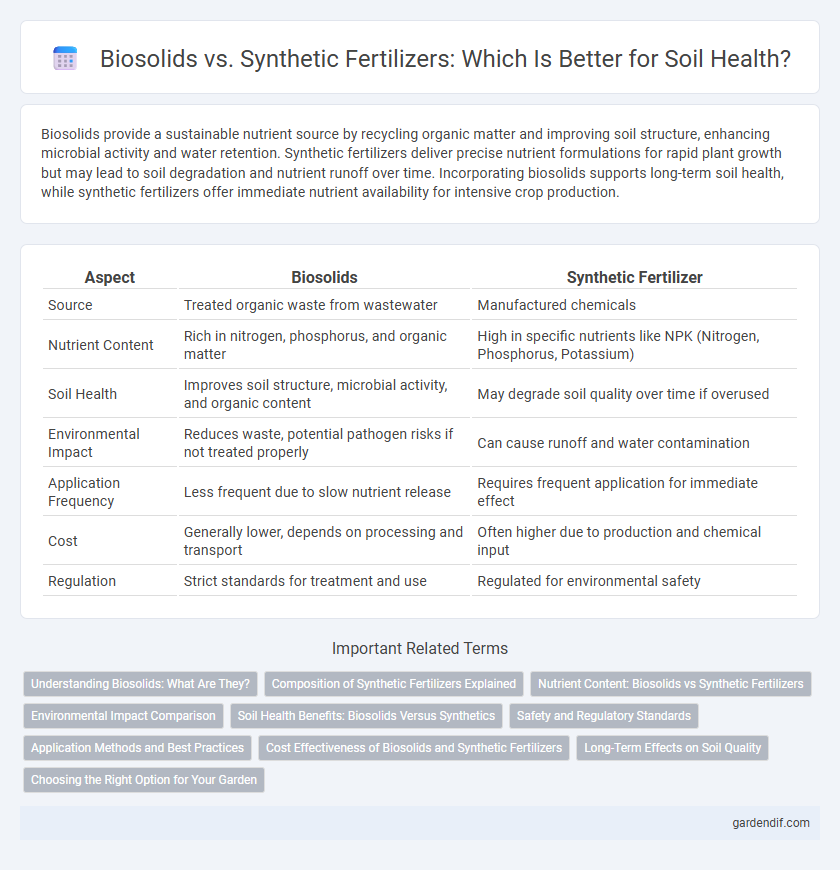
Biosolids vs Synthetic fertilizer Illustration
Biosolids provide a sustainable nutrient source by recycling organic matter and improving soil structure, enhancing microbial activity and water retention. Synthetic fertilizers deliver precise nutrient formulations for rapid plant growth but may lead to soil degradation and nutrient runoff over time. Incorporating biosolids supports long-term soil health, while synthetic fertilizers offer immediate nutrient availability for intensive crop production.
Table of Comparison
| Aspect | Biosolids | Synthetic Fertilizer |
|---|---|---|
| Source | Treated organic waste from wastewater | Manufactured chemicals |
| Nutrient Content | Rich in nitrogen, phosphorus, and organic matter | High in specific nutrients like NPK (Nitrogen, Phosphorus, Potassium) |
| Soil Health | Improves soil structure, microbial activity, and organic content | May degrade soil quality over time if overused |
| Environmental Impact | Reduces waste, potential pathogen risks if not treated properly | Can cause runoff and water contamination |
| Application Frequency | Less frequent due to slow nutrient release | Requires frequent application for immediate effect |
| Cost | Generally lower, depends on processing and transport | Often higher due to production and chemical input |
| Regulation | Strict standards for treatment and use | Regulated for environmental safety |
Understanding Biosolids: What Are They?
Biosolids are nutrient-rich organic materials derived from the treatment of wastewater sludge, containing essential elements like nitrogen, phosphorus, and micronutrients beneficial for soil health. Unlike synthetic fertilizers, biosolids improve soil structure, moisture retention, and microbial activity while recycling waste sustainably. Their regulated application promotes environmental protection by reducing reliance on chemical inputs and minimizing nutrient runoff.
Composition of Synthetic Fertilizers Explained
Synthetic fertilizers are primarily composed of concentrated nutrients like nitrogen, phosphorus, and potassium, often in the form of ammonium nitrate, superphosphate, and potassium chloride. These fertilizers typically lack organic matter and micronutrients that biosolids naturally contain, which contribute to soil structure and microbial activity. The highly soluble nature of synthetic nutrients allows for rapid plant uptake but may increase the risk of nutrient leaching and soil degradation over time.
Nutrient Content: Biosolids vs Synthetic Fertilizers
Biosolids contain a balanced range of essential nutrients, including nitrogen, phosphorus, and micronutrients, released gradually to improve soil fertility over time. Synthetic fertilizers provide concentrated doses of specific nutrients, often higher in nitrogen and phosphorus content but lack organic matter and micronutrients. The slow nutrient release from biosolids supports sustained plant growth and soil health, whereas synthetic fertilizers offer immediate nutrient availability but may require repeated application.
Environmental Impact Comparison
Biosolids enhance soil organic matter and reduce reliance on chemical inputs, leading to lower greenhouse gas emissions compared to synthetic fertilizers. Synthetic fertilizers often contribute to nutrient runoff, causing waterway eutrophication and soil acidification. Applying biosolids supports sustainable nutrient cycling and reduces environmental pollution risks linked to synthetic fertilizer use.
Soil Health Benefits: Biosolids Versus Synthetics
Biosolids enhance soil health by improving organic matter content, increasing microbial activity, and boosting nutrient retention, which supports sustainable soil ecosystems. Synthetic fertilizers primarily supply specific nutrients like nitrogen, phosphorus, and potassium but often lack the organic matter necessary for long-term soil structure and microbial diversity. Continuous use of biosolids promotes soil fertility and reduces erosion risks, whereas synthetic fertilizers can lead to nutrient imbalances and potential soil degradation.
Safety and Regulatory Standards
Biosolids must meet stringent EPA regulations under 40 CFR Part 503, ensuring they are treated to reduce pathogens and heavy metals to safe levels before land application. In contrast, synthetic fertilizers are subject to less rigorous regulatory scrutiny but carry risks of nutrient leaching and chemical runoff. The safety profile of biosolids is enhanced by comprehensive monitoring programs, making them a sustainable alternative to conventional synthetic fertilizers when adhering to established environmental standards.
Application Methods and Best Practices
Biosolids application methods such as surface spreading, injection, and incorporation differ significantly from synthetic fertilizers, requiring careful timing and soil moisture monitoring to maximize nutrient uptake and minimize environmental impact. Best practices for biosolids emphasize site-specific assessments, pathogen reduction through proper treatment, and adherence to regulatory guidelines to ensure safe use. Synthetic fertilizers benefit from precision application techniques like fertigation and controlled-release formulations, which enhance nutrient use efficiency while reducing runoff and leaching risks.
Cost Effectiveness of Biosolids and Synthetic Fertilizers
Biosolids offer significant cost advantages over synthetic fertilizers due to their lower purchase price and their ability to improve soil health, reducing the need for additional soil amendments. Synthetic fertilizers often require higher upfront investment and frequent application to maintain nutrient levels, increasing long-term costs. The nutrient recycling in biosolids also enhances soil organic matter, leading to sustained productivity and cost savings in agricultural management.
Long-Term Effects on Soil Quality
Biosolids improve soil structure and increase organic matter content, enhancing microbial activity and nutrient retention over time, which supports sustained soil fertility. Synthetic fertilizers provide immediate nutrient availability but may lead to soil acidification, reduced microbial diversity, and nutrient imbalances with prolonged use. Long-term application of biosolids promotes healthier soil ecosystems, while synthetic fertilizers risk degrading soil quality and resilience.
Choosing the Right Option for Your Garden
Biosolids provide a nutrient-rich, organic alternative to synthetic fertilizers, improving soil structure and microbial activity for long-term garden health. Synthetic fertilizers offer precise nutrient control and quick release, ideal for rapid plant growth but can lead to soil degradation over time. Selecting the right option depends on soil testing results, garden goals, and environmental impact considerations to achieve balanced nutrient management.
Biosolids vs Synthetic fertilizer Infographic

 gardendif.com
gardendif.com